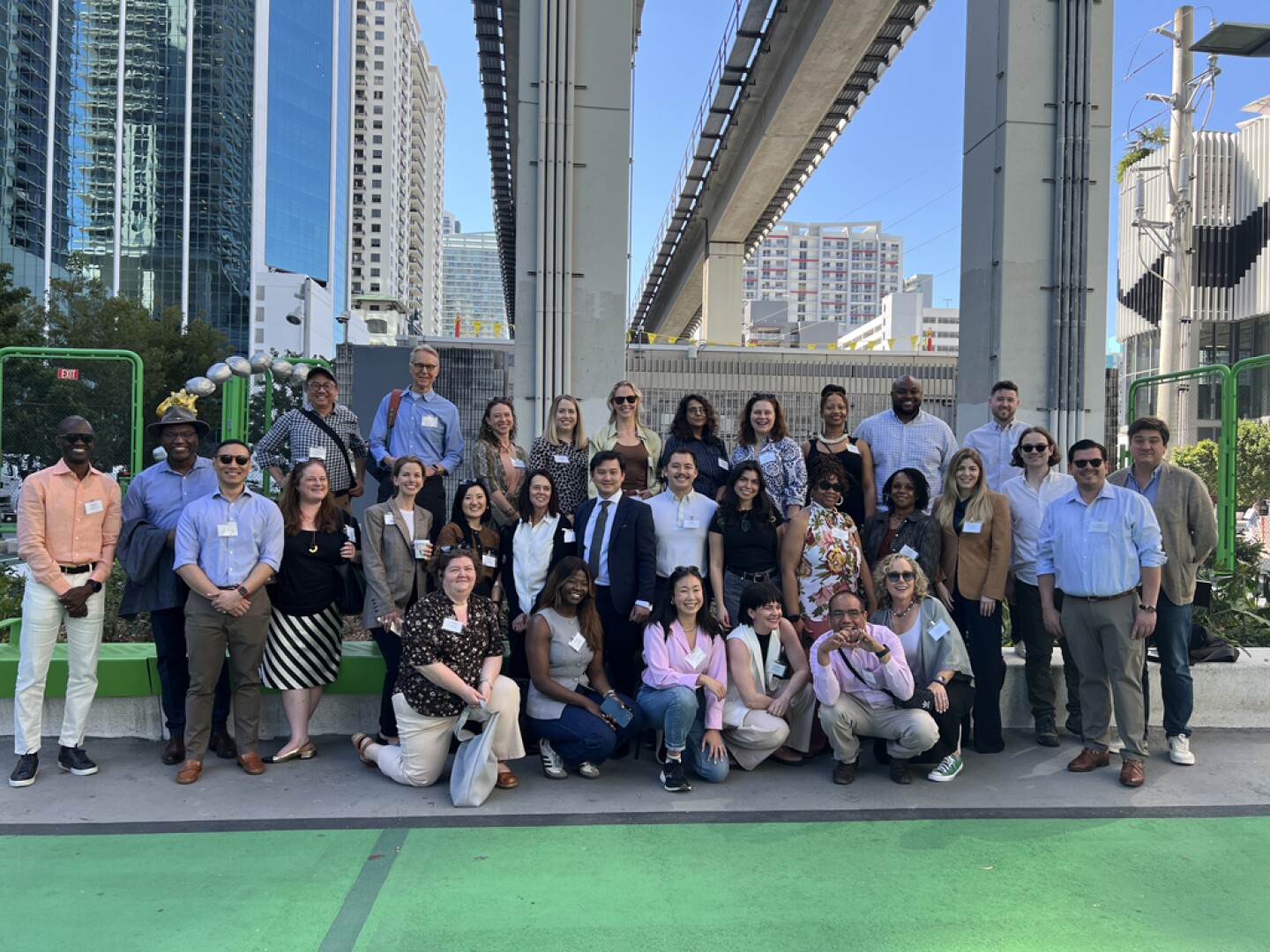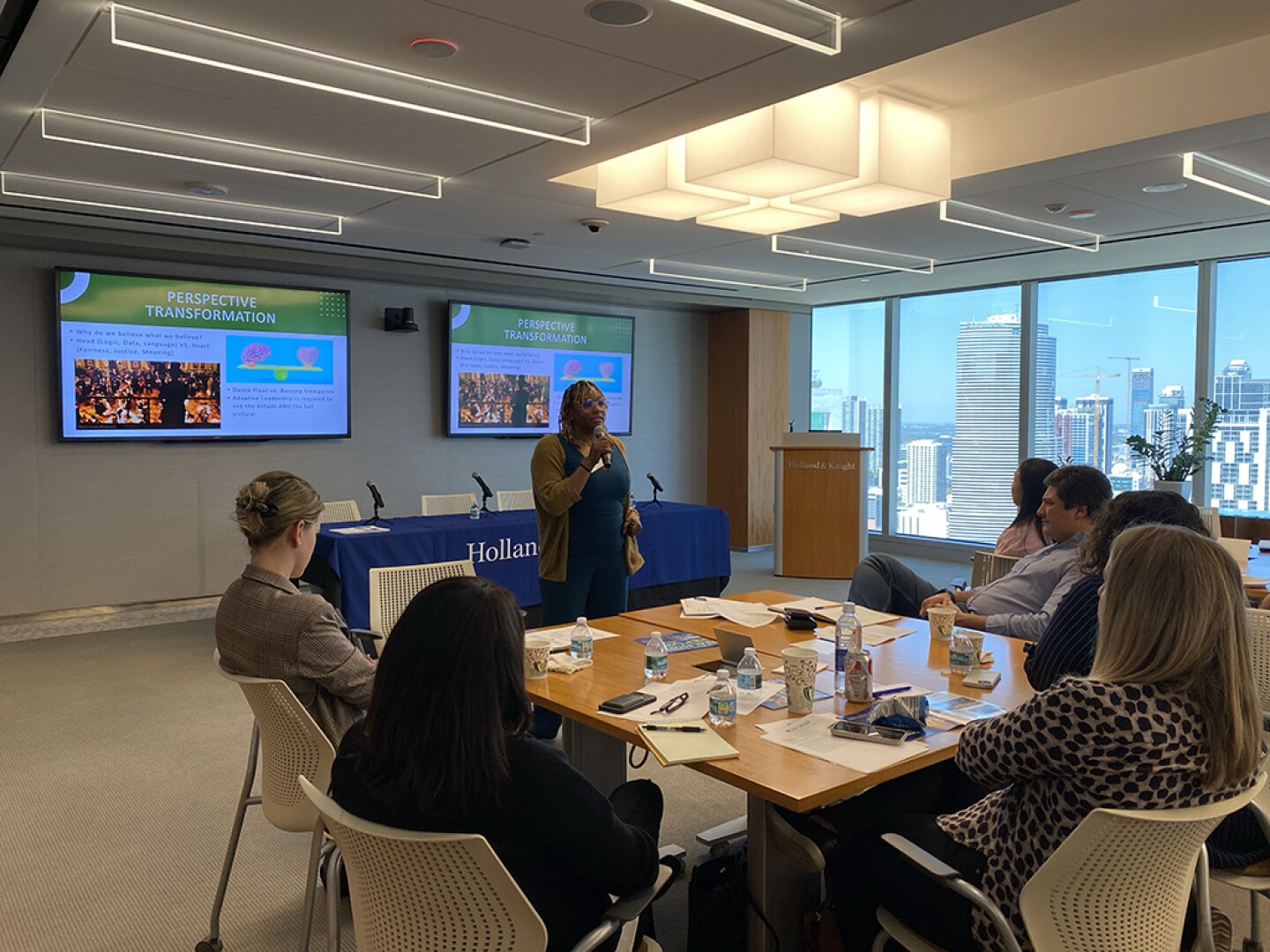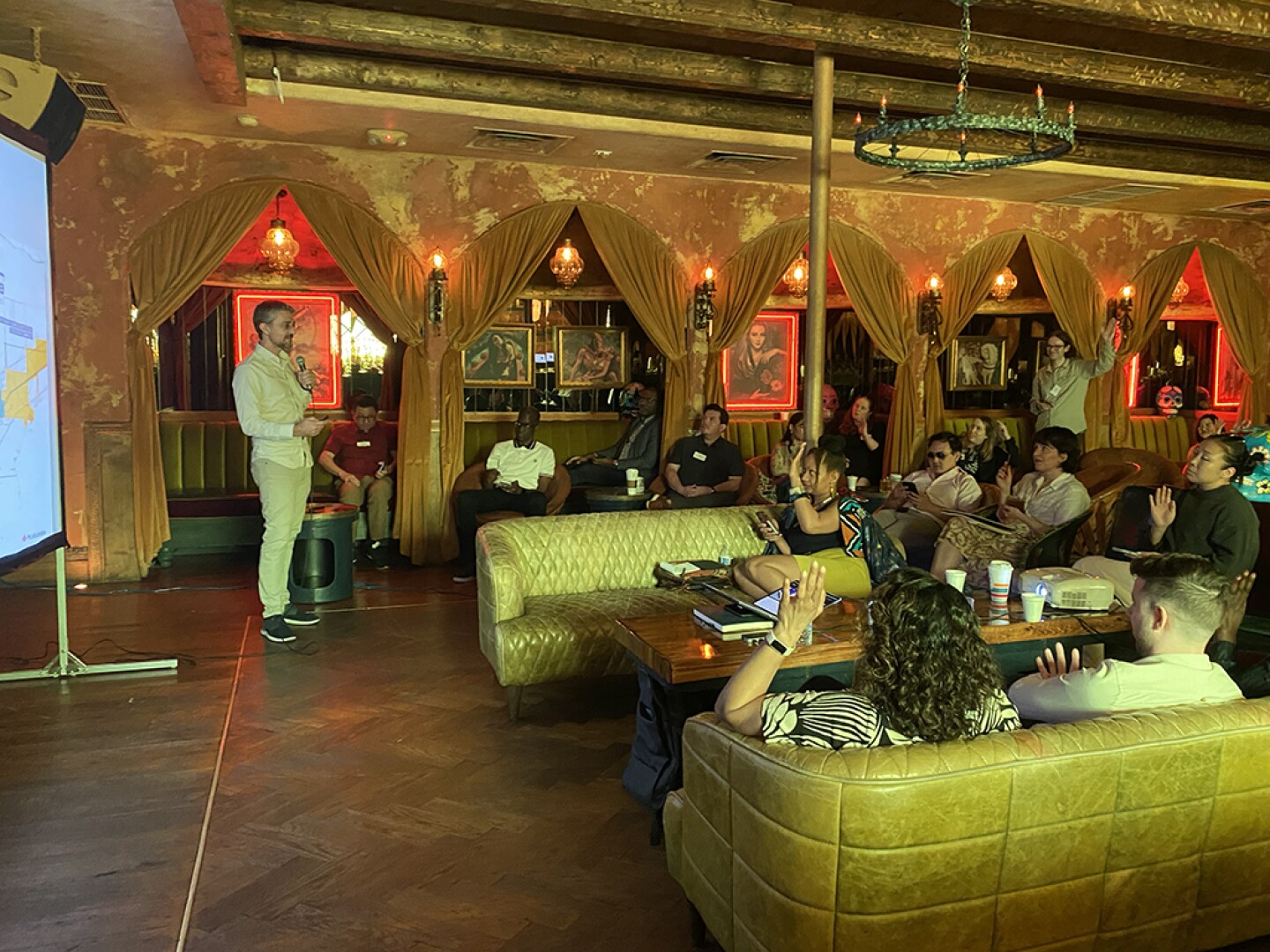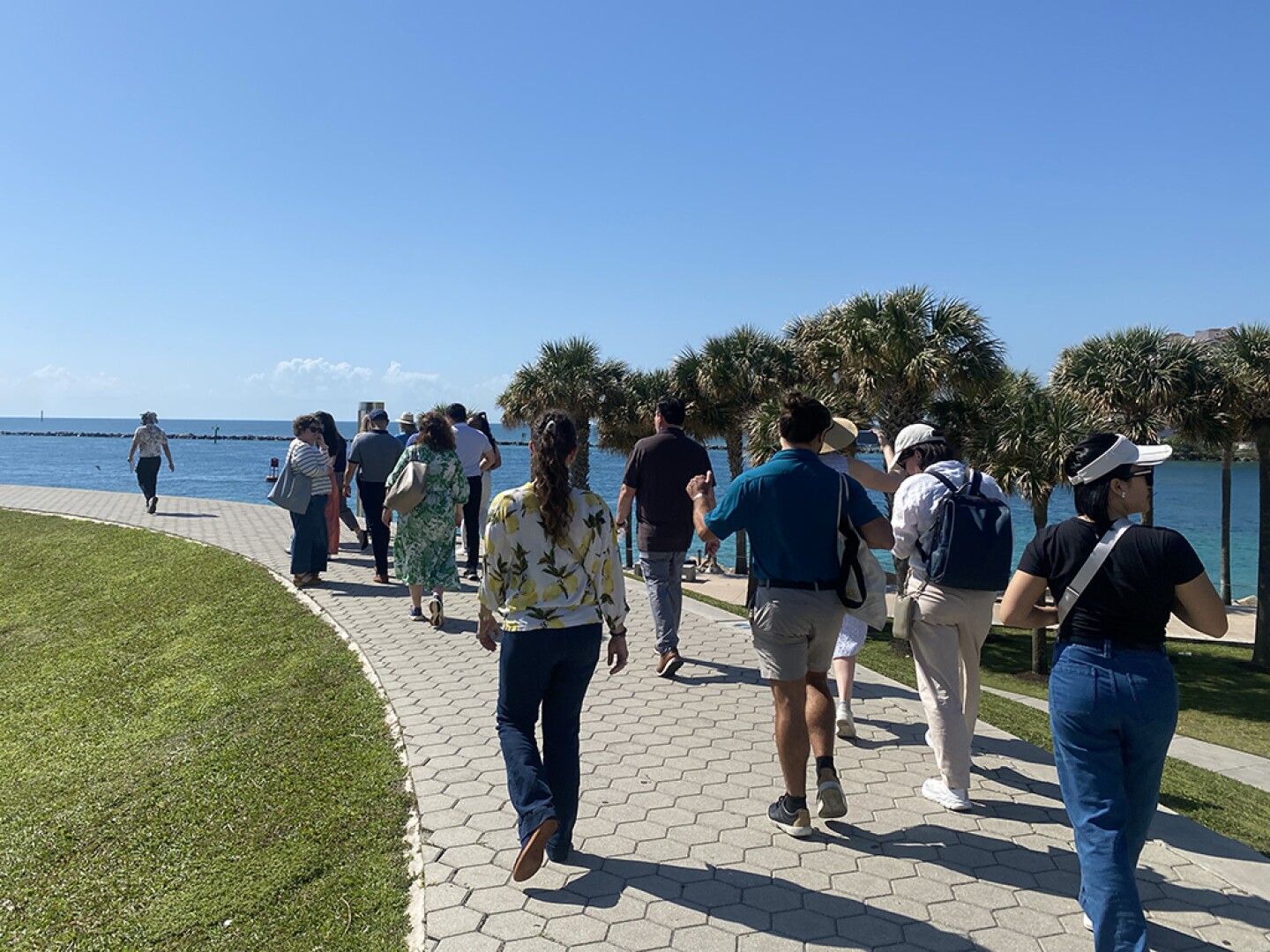The ULI Health Leaders Network was established in 2017 to connect ULI members across disciplines such as architecture, urban planning, development, and community health. Over the course of a year, the cohort program establishes working relationships through two in-person convenings in world-class cities and monthly virtual meetings. Cohort 8 includes 28 talented professionals representing 25 different cities and six different countries, adding to the 250+ member network of Health Leaders. Learn more about this year’s cohort.
This past March, Cohort 8’s Health Leaders came together in Miami, Florida, to share experiences old and new. The introductory forum explored Miami’s efforts to weave health and equity in its vibrant built environment through community, culture, and conservation.
Are you interested in becoming the next Health Leader? Applications for Cohort 9 will open Summer 2025 to join this transformative program. Visit uli.org/healthleaders to learn more about selection criteria, program dates, and the application process.
A city renowned for its vibrant culture and sweeping coastal skyscrapers, Miami set the stage for this year’s ULI Health Leaders Network Introductory Forum. Spanning the course of three days, Cohort 8 learned from local practitioners and explored the various ways in which the city marries real estate and land use with health and social equity. The Health Leaders toured historical and contemporary neighborhoods, provoking thoughtful discussion on how Miami development compared to their own local contexts.
Reclaiming the Miami Metrorail’s Shadow
Day one of the forum kicked off with a discussion of how public spaces can be transformative for the urban fabric of the city and improve the quality of life for community members. The day focused on the development of The Underline, a local public/private partnership park built under the shade of a raised Metrorail line.
Representing The Underline were Patrice Gillespie Smith, president and COO of Friends of The Underline; Anamarie Ferreira de Melo, co-founder and principal of Urban Health Solutions; and Casey Munga, a Miami community member—each of whom have played a direct role in the project’s growth and advocacy. Gillespie Smith and Ferreira de Melo spoke to the importance of community involvement, diversified funding streams, and engagement with local business to guarantee the success of The Underline’s development.
The expert guests shared the impact the development has had on both an individual and city scale, including Munga, who reflected on how The Underline transformed her health from incurable to infallible. For Health Leader Jason Brown, president and CEO of Dallas City Homes, “It was inspiring to see how strategic infrastructure investments are enhancing quality of life and fostering a stronger, more connected community.”
The presentation of The Underline was followed by an interactive workshop on social equity led by Tiffany Young of Think Equity. Young’s session sought to teach Health Leaders how to integrate equity concepts into their organizations, programs, policies, and practices.
“This workshop challenged my assumptions and deepened my understanding of cultural intelligence, adaptive leadership, and what it truly means to create equitable spaces,” says Health Leader Amber Nyoni from Essex County Council. “It was a powerful reminder that addressing the social determinants of health requires more than just technical expertise but demands cultural competence, intentional collaboration, and a willingness to challenge existing structures.”
Revitalizing a Cultural Community Tapestry
On the second day, the forum focused on exploring the historical foundation on which Miami was built. The day started with a presentation by Megan McLaughlin of Plusurbia Design. McLaughlin covered Miami’s evolution from humble beginnings to what is now nicknamed the Magic City.
McLaughlin explained how the mix of Miami’s deep colonial history, pivotal railroad transformation, the 1920s development boom, and immigration influx has woven unique threads in the city’s historical tapestry and helped shape it to what it is today. As the director of preservation projects at Plusurbia, McLaughlin highlighted to Health Leaders how one needs to understand the historical context of a city to strategically plan and protect the character of established neighborhoods.
To compliment McLaughlin, Plusurbia’s founding principal, Juan Mullerat, followed with a presentation on the firm’s award-winning revitalization plan of Wynwood Norte. Wynwood Norte sits in a unique location with modern development pressures on all sides and therefore at risk of losing its cultural identity. Mullerat emphasized how the plan is community-focused by introducing methods to reduce displacement and increase affordability, including looking closely at zoning and the scale of buildings in the neighborhood, seeking to preserve Wynwood Norte’s historical character for generations to come.
The presentations were followed by a tour of Wynwood Norte and the neighboring Design District, Midtown, and Wynwood. Walking through these bordering neighborhoods, Cohort 8 was able to experience the stark dichotomy of historical against contemporary. Health Leader Mark Drane, director of Urban Habitats, found Plusurbia’s work striking and noted, “It’s sometimes difficult to see where the opportunities are or how to make them come to fruition, so to hear from these two passionate practitioners was inspiring.”
Later in the afternoon, Cohort 8 dove deeper into Miami’s cultural context with a presentation on Little Havana. Coupled with a tour of this neighborhood in the heart of Miami, Health Leaders learned from Mullerat; Martin Pinilla of Barlington Group; and Raissa Fernandez of Healthy Little Havana.
Little Havana is one of Miami’s first and biggest ethnic neighborhoods, existing as a melting pot for Central American, Mexican, Asian, and other cultures. It has existed as a place of generational stability for immigrant families since the 1960s. Like Wynwood Norte, Little Havana is at risk of losing its cultural influence in the face of modern development.
This colorful neighborhood faces challenges with accessible health care on a local level, which is exacerbated by environmental issues such as air and noise pollution. The ability to surpass these barriers is challenged by a mix of political power and shifting influences, as noted by Fernandez, who grew up in Little Havana. She emphasized to Health Leaders that community involvement and investment are key to preserve culture while fostering responsible development in Little Havana and neighborhoods that are similarly challenged.
Resilience for a Changing Climate
The final day of the forum was dedicated to exploring Miami-Dade County’s local climate and the profound effects climate change has on health, safety, and welfare in urban planning and future growth and development. Health Leaders from the Office of Environmental Risk and Resilience and Miami-Dade County Parks, Recreation, and Open Spaces (PROS) shared insights into how the region is planning for resilience through community engagement and nature-based solutions.
At Biscayne Gardens Park, Cohort 8 learned about the innovative resilience and nature-based solutions implemented by PROS, including transformative bioswales. These efforts target high-risk communities, where flooding and extreme weather events are becoming increasingly common. Biscayne Gardens Park itself, with its lush natural landscape, illustrates a critical challenge: only a few inches of rain can change it from a green space to a temporary lake, highlighting the vulnerability of low-lying areas in Miami.
The county’s commitment to nature-based solutions—such as enhanced stormwater management and the strategic use of green infrastructure—provides a dual benefit. Not only do these solutions address flooding, but they also improve the aesthetics and overall health and well-being for the people visiting and living in the communities they serve. PROS master plan manager, Maria Reilly, noted, “Providing access to nature and opportunities for outdoor recreation is critical to the planning, design, and construction of public infrastructure not only in our parks, but also in our open spaces.” Planning urban projects that embrace, rather than fight against, the climate-related challenges within the built environment is a vital step in addressing health and resilience issues in Miami Dade’s neighborhoods.
During the final afternoon, Health Leaders participated in a guided tour of the City of Miami Beach South Pointe Park. Rolando Martinez, sustainability specialist with the City of Miami Beach, led the group through the park, sharing his expertise on how South Pointe Park balances the demand for high-end real estate with the pressing realities of rising sea levels. As part of the City’s efforts to mitigate these risks, the park has incorporated resilient infrastructure, including an ever-growing dune system, flood-resistant landscaping, elevated pathways, and sustainable stormwater management systems.
“Ambitious as the resilience initiatives are for the city, navigating the political climate continues to be the biggest barrier in funding initiatives that help build healthier, more sustainable urban environments,” reflected Health Leader Sem Lee, founder and director at OURI Labs, “This highlights the growing need for us to come together to drive the agenda of delivering healthy places not only locally but also by bridging gaps across borders and internationally.”
This last day of the forum underscored the importance of resilience in urban planning—particularly in Miami, where the effects of climate change are already being felt. Health Leaders left with a deeper understanding of how nature-based solutions, community engagement, and sustainable planning can protect both the environment and the health of residents, and the need to engage across disciplines and form public/private partnerships to ensure these protections are incorporated in land use decisions and developments.
Reflections from The Magic City
Cohort 8’s Introductory Forum in Miami focused on the city’s unique challenges and opportunities from restoration of underused open spaces such as The Underline, to understanding Miami’s history in context for development, to lessons on building resilience against climate change for long-lasting health. Each day came together to highlight the crucial role that local initiatives, green spaces, and sustainable design play in fostering healthier urban places.
The following are reflections from Cohort 8 members, who share their key takeaways after spending time studying health and equity in Miami’s built environment.
Sem Lee, founder and director, OURI Labs (London, England): “I was particularly struck by our speaker presentations that highlighted Miami’s colonial history and its more recent population and real estate boom. Learning about the city’s evolution over recent centuries provided valuable context for understanding today’s challenges. I enjoyed hearing about our cohort’s reflections throughout our trip and having the opportunity to understand the perspectives of those coming from different backgrounds. It helped me to reflect on how we might implement creative strategies to maintain livability despite complex pressures relating to climate risk and resilience.
The trip provided me with hope knowing that I am part of a network where we are all doing this within our communities and look forward to the continued collaboration across the program.”
Jason Brown, president and CEO, Dallas City Homes Inc. (Dallas, Texas): “What surprised me most during the ULI Health Leaders’ Cohort in Miami was the impressive grassroots efforts throughout neighborhoods surrounding the multitude of skyscrapers, driving a healthier and more equitable city. I was particularly struck by the resiliency and determination of local organizations and residents working tirelessly to create lasting change, despite the challenges posed by rapid urban growth and socioeconomic disparities. Overall, this experience served as a powerful reminder of the similar work I’m leading in my own community. It was refreshing and encouraging to see others driving meaningful change. This is one of the main reasons I wanted to be part of this cohort—the opportunity to connect with others equally committed to building more inclusive and resilient cities for all.”
ULI Healthy Places would like to express its gratitude to the invaluable local partners whose collaboration and passion for sharing their work made the forum possible. Special thanks to ULI Southeast Florida/Caribbean, The Underline, Tiffany Young, Holland & Knight, Martin Pinilla II, Juan Mullerat, Megan McLaughlin, Plusurbia, Raissa Fernandez, and the Miami-Dade County Office of Resilience for their pivotal contributions.
ULI is grateful to the Robert Wood Johnson Foundation and ULI Trustee Randall Lewis for their generous support of this program.










